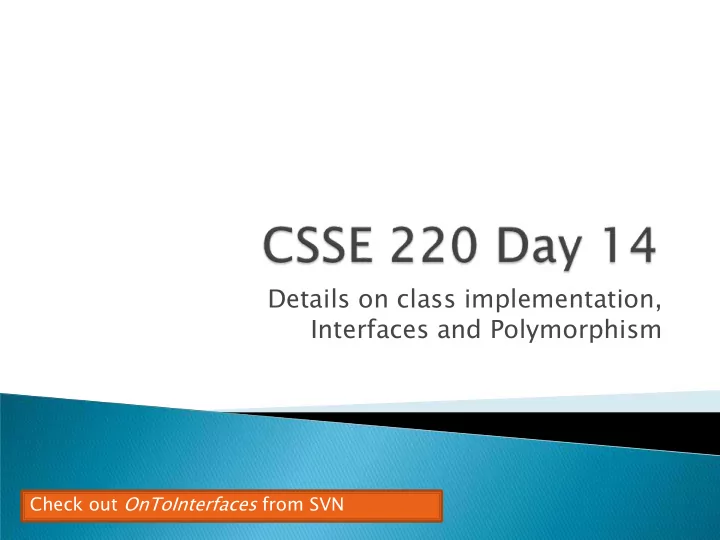

Details on class implementation, Interfaces and Polymorphism Check out OnToInterfaces from SVN
Static fields and methods Variable scope Packages Interfaces and polymorphism
public static void main(String[] args) { double x= 1.0; double y = 2.5; swapOrNot(x,y); System.out.println("x is " + x); } private static void swapOrNot(double a, double b) { double temp = a; a = b; b = temp; } Draw a box-and-pointer diagram and predict the output. Q1
static members (fields and methods)… ◦ are not part of objects ◦ are part t of the class ss itself elf Mnemonic: objects can be passed around, but static members stay put
Cannot refer to this ◦ They aren’t in an object, so there is no this ! Are called without an implicit parameter ◦ Math.sqrt(2.0) Class s name, not object reference
Helper methods that don’t refer to this ◦ Example: creating list of Coordinates for glider Utility methods ◦ Example: public class Geometry3D { public static double sphereVolume(double radius) { … } } main() method ◦ Why static? What objects exist when program starts? Q2
We’ve seen static final fields Can also have static fields that aren’t final ◦ Should be private ◦ Used for information shared between instances of a class Q3
private static int nextAccountNumber = 100; or use “static initializer” blocks: public class Hogwarts { private static ArrayList<String> FOUNDERS; static { FOUNDERS = new ArrayList<String>(); FOUNDERS.add("Godric Gryfindor"); // ... } // … }
Polygon
Scope : the region of a program in which a variable can be accessed ◦ Parameter ameter scope pe : the whole method body ◦ Local al va vari riable able scope : from declaration to block end: public double area() { double sum = 0.0; Point2D prev = this.pts.get(this.pts.size() - 1); for (Point2D p : this.pts) { sum += prev.getX() * p.getY(); sum -= prev.getY() * p.getX(); prev = p; } return Math.abs(sum / 2.0); Q4 }
Member ber scope : anywhere in the class, including before its declaration ◦ This lets methods call other methods later in the class. public class members can be accessed outside the class using “qualified names” ◦ Math.sqrt() ◦ System.in Q5
public class TempReading { private double temp; public void setTemp(double temp) { … temp … this.temp = temp; } // … What does this } “temp” refer to? Always qualify field references with this . It prevents accidental shadowing. Q6
Static imports let us use unqualified names: ◦ import static java.lang.Math.PI; ◦ import static java.lang.Math.cos; ◦ import static java.lang.Math.sin; See the Polygon.drawOn() method
Let us group related classes We’ve been using them: ◦ javax.swing ◦ java.awt ◦ java.lang Can (and should) group our own code into packages ◦ Eclipse makes it easy… Q7
Remember the problem with Timer? ◦ Two Timer classes in different packages ◦ Was OK, because packages had different names Package naming convention: reverse URLs ◦ Examples: edu.roseHulman.csse.courseware.scheduling com.xkcd.comicSearch Groups related classes as Specifies the company sees fit company or organization Q8
Can use import to get classes from other packages: ◦ import java.awt.Rectangle; Suppose we have our own Rectangle class and we want to use ours and Java’s? ◦ Can use “fully qualified names”: java.awt.Rectangle rect = new java.awt.Rectangle(10,20,30,40); ◦ U-G-L-Y, but sometimes needed.
I don’t even want this package. Why did I sign up for the stinging insect of the month club anyway?
Express common operations that multiple classes might have in common Make “client” code more reusable Provide method signatures and docs. Do not provide implementation or fields Q9
Interface types are like contracts acts ◦ A class can promise to implement lement an interface That is, implement every method ◦ Client code knows that the class will have those methods ◦ Any client code designed to use the interface type can automatically use the class!
Charges
interface, not class public interface Charge { /** * regular javadocs here */ Vector forceAt(int x, int y); /** No “public”, No method automatically body, just a * regular javadocs here are so semi-colon */ void drawOn(Graphics2D g); } public class PointCharge implements Charge { … PointCharge Charge promises to implement all the } methods declared in the Charge ge interface
Distinguishes interfaces from classes <<interface>> Space Charge Hollow, closed triangular tip means PointCharge LinearCharge PointCharge is a a Charge Q10
Can pass an instan ance of a class where an interface type is expected ◦ But only if the class implements the interface We could pass LinearCharge s to Space ’s add(Charge c) method without changing Space ! Use interfac rface e types es for field, method parameter, and return types whenever possible Q11
Charge c = new PointCharge (…); Vector v1 = c.forceAt (…); c = new LinearCharge (…); Vector v2 = c.forceAt (…); The type of the actual l obje ject determines the method used. Q12
Origin: ◦ Poly many ◦ Morphism shape Classes implementing an interface give many y differently “shaped” objects for the interface type Late e Bi Binding ing: choosing the right method based on the actual type of the implicit parameter at run time Q13,14
Recommend
More recommend